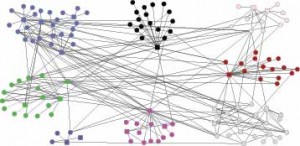How does coevolution shape large webs of interacting species?
Increasingly, we are asking questions about how large groups of species coevolve. Our studies began several decades ago when we studied local and geographic patterns in how plants may coevolve with local and migrating birds. Birds and plants with fleshy fruits form webs of interacting species that change seasonally as birds shift habitats and as waves of migrating birds move across ecosystems and continents. Avian migration has the potential to shape patterns of coevolution across continents.
Later these studies began using mathematical models and available data from other laboratories to ask how coevolution may shape interactions within large local webs of interacting species. We have been particularly interested in how evolution, even over short time scales, assembles species into webs (“networks”) and how extinction of species may affect subsequent evolution and coevolution within webs.
We are currently focusing on interactions among plants, pollinators, frugivores, fungi, and similar mutualistic interactions that are crucial for the functioning of most ecosystems worldwide but are under threat in many ecosystems.
Some of these studies, in collaboration with Hirokazu Toju of Kyoto University, have focused on analyses of the community-wide network structure of interactions between plants and mycorrhizal fungi (Toju et al. 2014, 2015m, 2017). These analyses use Toju’s large next-generation-sequencing datasets on the pattern of links between links and fungi to analyze network structure in Asian temperate, subtropical, and tropical forests.
Other collaborations include analyses of patterns in networks between plants and multiple kinds of mutualists such as pollinators and ants, based on datasets collected over many years by Victor Rico Gray and his colleagues in Mexico (Dáttilo et al. 2016 Proc. Royal Soc. B).
Our collaborative mathematical studies of coevolving webs are being led by Paulo Guimarães, who was a postdoctoral associate in our lab and is now on the faculty at the University of São Paulo, Brazil. Pedro Jordano from the Estación Biológica de Doñana in Seville, Spain and Jordi Bascompte from the University of Zurich are collaborating with us on these studies. See, for example, Guimarães et al. (2011) Ecology Letters. See also a discussion in Relentless Evolution (Thompson 2013). These studies have expanded in recent years to included analyses of coevolution in more complex webs, geographic mosaics of coevolution, and the comparative effects of direct and indirect fitness effects of species interactions in small and large networks (e.g., Guimarães et al. 2017 Nature, Lemos-Costa et al. 2017 J. Roy. Soc. Interface, Andreazzi et al. 2017 American Naturalist, Medeiros et al. 2018 PNAS, Fernandes et al. 2019).
